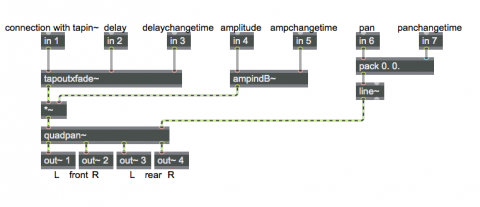Abstraction for delay with quadraphonic panning

This patch shows how you might combine several of the abstractions that are presented in other examples. The two key abstractions here are tapoutxfade~ and quadpan~. Those are not actual Max objects; they're both patches that have been saved with those names. They're explained in the examples "Abstraction for crossfading delay times of a remote tapin~ object" and "Quadraphonic panning based on radial angle", respectively. Another abstraction, ampindB~, is described in the example "Amplitude control in decibels". The tapoutxfade~ abstraction provides a delayed version of a sound, the ampindB~ abstraction provides an amplitude factor for that delayed sound, and the quadpan~ abstraction pans the sound among four speakers.
The patch is designed to be used inside a poly~ object. So, instead of the usual inlet and outlet objects, it uses in objects for input messages and out~ objects for outgoing sound signals. The intention is that the left inlet of the poly~ will be attached to a single tapin~ object in order to receive a tapconnect message and thus refer to a particular ring buffer, as described in the example "Abstraction for crossfading delay times of a remote tapin~ object". The remaining inlets provide information about delay time, amplitude, and panning position of each delayed sound, and transition times for those parameters.
When this abstraction is used within a poly~ object, it can be duplicated many times, to create a texture of many different delays with independent amplitude and panning. A separate part of the program would be needed to manage all the input parameters for this patch. That is demonstrated in another example, "Demonstration of multiple crossfading delay times referring to the same remote tapin~ object".
See also, for comparison, the example "Abstraction for delay with stereo panning" and related examples.